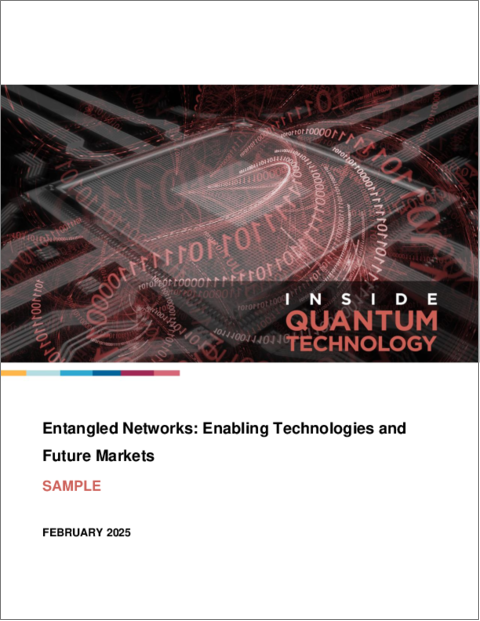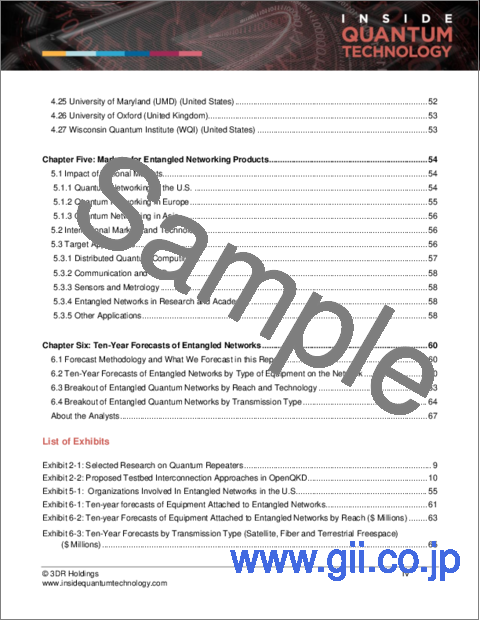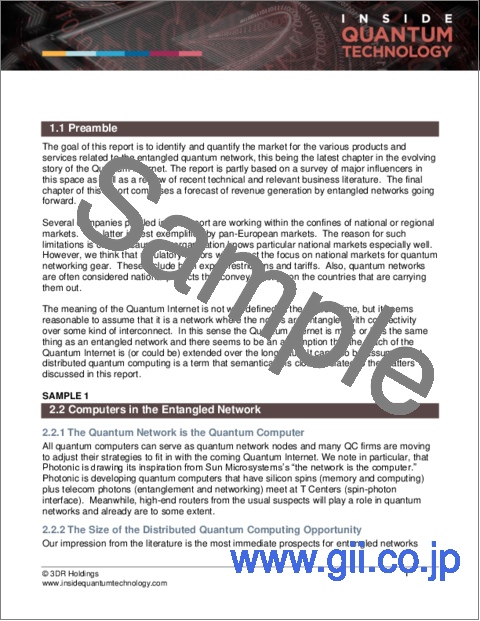|
|
市場調査レポート
商品コード
1652132
エンタングルドネットワーク:イネーブリング テクノロジーと将来の市場Entangled Networks: Enabling Technologies and Future Markets |
||||||
|
|||||||
| エンタングルドネットワーク:イネーブリング テクノロジーと将来の市場 |
|
出版日: 2025年02月07日
発行: Inside Quantum Technology
ページ情報: 英文 72 Pages
納期: 即納可能
|
全表示
- 概要
- 目次
量子インターネットの定義はまだ明確ではありません。とはいえ、ノードが何らかの量子インターコネクトを介してエンタングル接続されたネットワークであると考えるのが妥当です。
この分野における現在の活動の多くは、調査と呼ぶのが妥当かもしれないです。長距離エンタングルドネットワークが一般的になるまでには、まだ長い道のりがあります。北米や欧州を中心に、量子ネットワーキングのテストベッドは増えつつあるが、その多くは研究開発指向のものです。エンタングル量子ネットワーキングがユビキタスになるまでには、量子中継器の開発が必要です。量子中継器が実用化されるまでは、量子インターネットのトラフィックの多くは衛星経由で伝送されると予想されます。本レポートでは、エンタングルドネットワークが現在どのような状況にあり、今後数年でどのような状況になるのかについて詳しく解説します。
今のところ、量子ネットワーキングの最も注目すべき応用は、量子コンピュータをネットワークでつなぐ分散量子コンピューティングです。これは、古典的なコンピュータをネットワーク化し、処理能力、メモリ、ストレージを向上させるハイパフォーマンス・コンピューティング(HPC)と類似しています。同様に、量子コンピューターをネットワーク化することで、従来よりも大きな問題に取り組むことが可能になります。今日、量子コンピュータを接続するエンタングルドネットワークに焦点が当てられていますが、IQTの研究では、量子センサーが成熟するにつれて、エンタングルドネットワークのコンセプトを量子モノのインターネット(QIoT)に拡張する可能性が大きいと考えられています。
当レポートでは、エンタングルドネットワークの現在と新たな機会を特定し、技術的課題、規制、標準、応用開発など、エンタングルドネットワークが直面する多くの課題についても網羅しています。
目次
第1章 エグゼクティブサマリー
第2章 エンタングルドネットワーク技術の製品とロードマップ
- イントロダクション
- エンタングルドネットワークのコンピュータ
- 量子通信機器および相互接続
- 量子センサーとQIoT
- エンタングルドネットワークのコンポーネント
- 衛星とドローンの役割
- 量子ネットワーキング製品スイート
- 量子インターネットソフトウェア:次世代
- 市場の差別化要因
第3章 エンタングルドネットワーク分野における現在の商業活動
- イントロダクション
- ADVA Network Security(ドイツ)
- Aliro Quantum(米国)
- AWS Center for Quantum Networking(米国)
- Boeing(米国)
- BT Group(英国)
- Cisco Systems(米国)
- evolutionQ(カナダ)
- Icarus Quantum(米国)
- Infleqtion(米国)
- IBM(米国)
- IonQ(米国)
- Ki3 Photonics Technologies(カナダ)
- levelQuantum(イタリア)
- L3Harris(米国)
- LQUOM(日本)
- MagiQ Technologies(米国)
- memQ(米国)
- NanoQT(日本)
- Nippon Telegraph and Telephone Corporation (NTT)(日本)
- Nu Quantum(英国)
- Photonic(カナダ)
- QphoX(オランダ)
- QTD Systems (米国)
- Quantum Bridge(カナダ)
- Quantum Corridor(米国)
- Quantum Industries GmbH(オーストリア)
- Quantum Network Technologies (Qunett)(米国)
- Quantum Optics Jena GmbHH(ドイツ)
- Qunnect(米国)
- SpeQtral(シンガポール)
- Welinq(フランス)
第4章 調査とテストベッド
- イントロダクション
- A*STAR Quantum Innovation Center (Q.InC) (シンガポール)
- Air Force Research Laboratory (AFRL)(米国)
- Argonne National Laboratory(米国)
- Brookhaven National Laboratory (BNL)(米国)
- Center for Quantum Networks (CQN) ((米国)
- Chicago Quantum Exchange (米国)
- DistriQ Quantum Innovation Zone(カナダ)
- ICFO(スペイン)
- Lawrence Berkeley National Laboratory (LBNL) (米国)
- Max Planck Institute of Optics(ドイツ)
- Novum Industria(米国)
- Numana(カナダ)
- Q-NEXT Science Center (米国)
- OpenQKD and Successor Testbeds
- QIQB Center for Quantum Information and Quantum Biology(日本)
- Quantum Communications Hub(英国)
- Quantum Flagship(EU)
- Saarland University(ドイツ)
- The University of Amherst, Massachusetts(米国)
- The University of Geneva, Group of Applied Physics(スイス)
- The University of Innsbruck(オーストリア)
- The University of Science and Technology of China(中国)
- TU Delft and QuTech (オランダ)
- University of Maryland(米国)
- University of Oxford(英国)
- Wisconsin Quantum Institute(米国)
第5章 エンタングルドネットワーク製品の市場
- 国内市場の影響
- 米国における量子ネットワーキング
- 欧州における量子ネットワーキング
- アジアにおける量子ネットワーキング
- 国際市場とテクノロジー
- 対象用途
- 分散量子コンピューティング
- 通信とQKD
- センサーと計測
- 調査と学術界におけるエンタングルドネットワーク
- その他
第6章 エンタングルドネットワークの10年間予測
アナリストについて
The Quantum Internet remains ill defined. Nevertheless, it is reasonable to assume that it is a network where the nodes are entangled with connectivity over some kind of quantum interconnect. With this in mind, IQT Research is publishing this report which identifies the current and emerging opportunities for Entangled Networks. Our report also provides coverage of the many challenges faced by entangled networks including technical issues, regulations, standards and applications development.
The report is partly based on a survey of major influencers in this space as well as a review of recent technical and relevant business literature. The final chapter of this report comprises a ten-year forecast of deployment and revenue generation by entangled networks by (1) types of attached equipment, (2) media and (3) reach.
Much of the current activity in this space might be reasonably designated as research. We still have a long way to go before long-haul entangled networks become common. There are a growing number of quantum network testbeds, especially in North America and Europe, but again much of the activity - the applications in testbeds - are R&D oriented. Before entangled quantum networks become ubiquitous, quantum repeaters will need to be developed. Until quantum repeaters are commercialized, we anticipate that a lot of Quantum Internet traffic will be carried over satellites. This report goes into detail about where the Entangled Network is today and what it will become over the next few years.
For now, the most noteworthy target application of quantum networks is distributed quantum computing, the networking together of quantum computers. A parallel can be drawn here with high performance computing (HPC), which networks classical computers together to increase the available processing power, memory, and storage. Similarly, networking quantum computers together will enable larger problems to be tackled than would otherwise be the case. While the focus today is on entangled networks that connect quantum computers, IQT research believes that there is much potential to extend the Entangled Network concept to a Quantum Internet of Things (QIoT) as quantum sensors mature.
Table of Contents
Chapter One: Executive Summary
- 1.1. Preamble
- 1.2. Timeframe for Entangled Networks: The Importance of Quantum Repeaters
- 1.3. Target Applications for the Entangled Network
- 1.3.1. Distributed Quantum Computing
- 1.3.2. Sensors and Metrology
- 1.3.3. Entangled Networks in Research and Academia
- 1.3.4. Other Applications
- 1.4. Timeframe for Entangled Networks: Protocols are also Critical
- 1.5. Components for Entangled Quantum Networks
- 1.6. Challenges on the Way to the Entangled Network
Chapter Two: Products and Roadmaps for Entangled Networks Technologies
- 2.1. Introduction
- 2.2. Computers in the Entangled Network
- 2.2.1. The Quantum Network is the Quantum Computer
- 2.2.2. The Size of the Distributed Quantum Computing Opportunity
- 2.2.3. Types of Quantum Computer Networks: Workgroups, Metro and Long-Haul
- 2.3. Quantum Communications Equipment and Interconnects
- 2.3.1. Quantum Repeaters
- 2.3.2. Entangled QKD
- 2.4. Quantum Sensors and the QIoT
- 2.4.1. Quantum Clock and CSAC Networks
- 2.4.2. Other Quantum Sensor Networks
- 2.5. Components of the Entangled Quantum Network
- 2.5.1. Quantum Interconnects
- 2.5.2. Quantum Memories
- 2.5.3. Photonic Sources for Quantum Networks
- 2.5.4. Detectors and other Components
- 2.6. The Role of Satellites and Drones
- 2.7. Quantum Network Product Suites
- 2.8. Quantum Internet Software: The Next Generation
- 2.8.1. Protocols for the Coming Entangled Network
- 2.9. Market Differentiators
Chapter Three: Current Commercial Activity in the Entangled Networks Space
- 3.1. Introduction
- 3.2. ADVA Network Security (Germany)
- 3.3. Aliro Quantum (United States)
- 3.4. AWS Center for Quantum Networking (CQN) (United States)
- 3.5. Boeing (United States)
- 3.6. BT Group (United Kingdom)
- 3.7. Cisco Systems (United States)
- 3.8. evolutionQ (Canada)
- 3.9. Icarus Quantum (United States)
- 3.10. Infleqtion (United States)
- 3.11. IBM (United States)
- 3.12. IonQ (United States)
- 3.13. Ki3 Photonics Technologies (Canada)
- 3.14. levelQuantum (Italy)
- 3.15. L3Harris (United States)
- 3.16. LQUOM (Japan)
- 3.17. MagiQ Technologies (United States)
- 3.18. memQ (United States)
- 3.19. NanoQT (Japan)
- 3.20. Nippon Telegraph and Telephone Corporation (NTT) (Japan)
- 3.21. Nu Quantum (United Kingdom)
- 3.22. Photonic (Canada)
- 3.23. QphoX (The Netherlands)
- 3.24. QTD Systems (United States)
- 3.25. Quantum Bridge (Canada)
- 3.26. Quantum Corridor (United States)
- 3.27. Quantum Industries GmbH (Austria)
- 3.28. Quantum Network Technologies (Qunett) (United States)
- 3.29. Quantum Optics Jena GmbH (Germany)
- 3.30. Qunnect (United States)
- 3.31. SpeQtral (Singapore)
- 3.32. Welinq (France)
Chapter Four: Research and Testbeds
- 4.1. Introduction
- 4.2. A*STAR Quantum Innovation Center (Q.InC) (Singapore)
- 4.3. Air Force Research Laboratory (AFRL) (United States)
- 4.4. Argonne National Laboratory (United States)
- 4.5. Brookhaven National Laboratory (BNL) (United States)
- 4.6. Center for Quantum Networks (CQN) (United States)
- 4.7. Chicago Quantum Exchange (United States)
- 4.8. DistriQ Quantum Innovation Zone (Canada)
- 4.9. ICFO (Spain)
- 4.10. Lawrence Berkeley National Laboratory (LBNL) (United States)
- 4.11. Max Planck Institute of Optics (Germany)
- 4.12. Novum Industria (United States)
- 4.13. Numana (Canada)
- 4.14. Q-NEXT Science Center (United States)
- 4.15. OpenQKD and Successor Testbeds
- 4.16. QIQB Center for Quantum Information and Quantum Biology (Japan)
- 4.17. Quantum Communications Hub (United Kingdom)
- 4.18. Quantum Flagship (EU)
- 4.19. Saarland University (Germany)
- 4.20. The University of Amherst, Massachusetts (United States)
- 4.21. The University of Geneva, Group of Applied Physics (GAP) (Switzerland)
- 4.22. The University of Innsbruck (Austria)
- 4.23. The University of Science and Technology of China (USTC) (China)
- 4.24. TU Delft and QuTech (The Netherlands)
- 4.25. University of Maryland (UMD) (United States)
- 4.26. University of Oxford (United Kingdom)
- 4.27. Wisconsin Quantum Institute (WQI) (United States)
Chapter Five: Markets for Entangled Networking Products
- 5.1. Impact of National Markets
- 5.1.1. Quantum Networking in the U.S.
- 5.1.2. Quantum Networking in Europe
- 5.1.3. Quantum Networking in Asia
- 5.2. International Markets and Technology
- 5.3. Target Applications
- 5.3.1. Distributed Quantum Computing
- 5.3.2. Communication and QKD
- 5.3.3. Sensors and Metrology
- 5.3.4. Entangled Networks in Research and Academia
- 5.3.5. Other Applications
Chapter Six: Ten-Year Forecasts of Entangled Networks
- 6.1. Forecast Methodology and What We Forecast in this Report
- 6.2. Ten-Year Forecasts of Entangled Networks by Type of Equipment on the Network
- 6.3. Breakout of Entangled Quantum Networks by Reach and Technology
- 6.4. Breakout of Entangled Quantum Networks by Transmission Type
About the Analysts
List of Exhibits
- Exhibit 2-1: Selected Research on Quantum Repeaters
- Exhibit 2-2: Proposed Testbed Interconnection Approaches in OpenQKD
- Exhibit 5-1: Organizations Involved In Entangled Networks in the U.S.
- Exhibit 6-1: Ten-year forecasts of Equipment Attached to Entangled Networks
- Exhibit 6-2: Ten-year Forecasts of Equipment Attached to Entangled Networks by Reach ($ Millions)
- Exhibit 6-3: Ten-Year Forecasts by Transmission Type (Satellite, Fiber and Terrestrial Freespace) ($ Millions)





